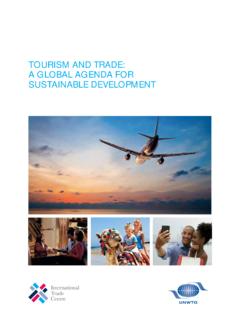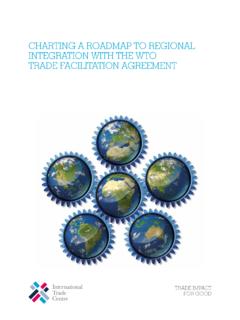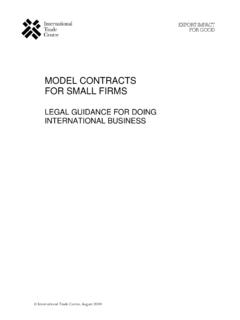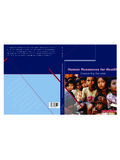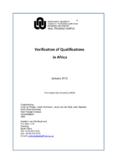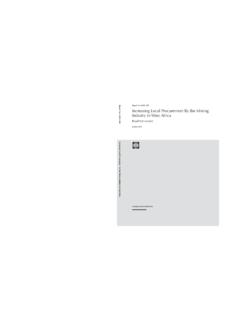Transcription of SME COMPETITIVENESS IN GHANA
1 SME COMPETITIVENESS IN GHANAALLIANCES FOR ACTIONIn collaboration withSME COMPETITIVENESS IN GHANAALLIANCES FOR ACTION2016 SME COMPETITIVENESS IN for trade information servicesID= 432142016C-16 288 SMEI nternational Trade Centre (ITC)SME COMPETITIVENESS in GHANA : Alliances for ActionGeneva: ITC, 2016. xii, 47 pages Doc. No. report, the first of a series of publications assessing SMEs COMPETITIVENESS ; based on a business survey conducted in GHANA in 2016, it analyses survey findings and compares them to other sources on SME COMPETITIVENESS and strengths and weaknesses related to the immediate and national business environment in GHANA ; covers manufacturing and agriculture sectors in Tema, Kumasi, and the Greater Accra Region; provides policy interventions based on the survey findings.
2 Presents results of an in depth analysis of the internal production system for a small sample of enterprises in the agro-processing sector; presents an action plan achieved through ITC Alliances for Action methodology and coordination among local partners as a result of this analysis; and includes bibliographic references ( ).Descriptors: GHANA , SMEs, COMPETITIVENESS , Global Value Chains, Trade further information on this technical paper, contact Valentina Rollo and Alliances for Action Suggested Citation:International Trade Centre (2016).
3 SME COMPETITIVENESS in GHANA : Alliances for , International Trade Centre (ITC) is the joint agency of the World Trade Organization and the United , Palais des Nations, 1211 Geneva 10, Switzerland ( )Digital image on the cover: Shutterstock International Trade Centre 2016 ITC encourages the reprinting and translation of its publications to achieve wider dissemination. Short extracts of this technical paper may be freely reproduced, with due acknowledgement of the source. Permission should be requested for more extensive reproduction or translation.
4 A copy of the reprinted or translated material should be sent to COMPETITIVENESS IN joint report of the International Trade Centre (ITC) and the Association of GHANA Industries (AGI) comes at a critical time. Many countries are facing challenges brought about by a weakened global economy: stagnant demand, persistent unemployment, increasing requirements for exports and financial vulnerability have all played their part in creating a deep sense of unease on where future sources of growth will come from.
5 This uncertain global outlook affects many actors throughout different value chains, but some groups are more affected than others; small and medium-sized enterprises (SMEs) are particularly susceptible to these increased pressures. This report intends to provide public and private stakeholders in GHANA and abroad with data and analysis necessary to steer Ghanaian SMEs successfully through challenging are critical economic drivers in most countries. This is no different in GHANA , where more than 85% of enterprises are SMEs.
6 Yet, recent studies suggest that the vast majority of SMEs fail to be competitive, to survive or to grow. Local, national and international institutions can help; they facilitate access to international markets and value chains through technical capacity building and knowledge sharing, ensuring that the resulting growth is both sustainable and inclusive. This joint report provides practical guidance on how to do Ghanaian government and relevant support institutions have started to implement strategies to enable sustainable and inclusive growth through different measures, including: the national export strategy, which focuses on non-traditional export diversification; the yam sector strategy, which created a roadmap for risk diversification strategies; the Made-in- GHANA campaign, that spurred local content development by making part of procurement conditions to supply locally.
7 And the GHANA Shared Growth and Development Agenda (GSGDA II), which has a strategy to leverage the country s natural resources by providing incentives for linking industry to the agriculture sector, hence promoting value addition. However, there is more to be done, and this joint report provides practical guidance on how to pursue is the only United Nations development agency fully dedicated to supporting the internationalization of SMEs. To deliver on the mandate of helping SMEs to join international markets, ITC developed the SME COMPETITIVENESS Survey, and has launched data collection exercises in several countries.
8 These efforts aim to assess the key elements that affect the COMPETITIVENESS of SMEs their capacity to connect, compete and change. The Association of GHANA Industries is one of the leading voices of the Ghanaian private sector, representing over 1,200 businesses and raising awareness about private-sector constraints through advocacy, capacity building and knowledge-sharing initiatives. Together, ITC and AGI have launched the first large-scale deployment of the SME COMPETITIVENESS Survey.
9 The survey effort also benefited from broad-based support from multiple partners, including: the Federation of Associations of Ghanaian Exporters (FAGE); the Ministry of Food and Agriculture of the Republic of GHANA ; the Ministry of Trade and Industry of the Republic of GHANA ; the GHANA National Chamber of Commerce; the GHANA Root Crops and Tubers Exporters Union (GROCTEU) and the GHANA Export Promotion Authority (GEPA). First findings of the Ghanaian SME COMPETITIVENESS Survey were featured prominently in ITC s SME COMPETITIVENESS Outlook 2016.
10 In addition, the detailed analysis of findings in this report will flow into further stakeholder discussions in GHANA with the aim of developing measures aimed at further strengthening SME COMPETITIVENESS . SME COMPETITIVENESS IN ITC COMPETITIVENESS Grid, used in this report, shows that enterprise performance depends not only on firm COMPETITIVENESS but also on external factors linked to the immediate business environment and national environment. This confirms that no enterprise or institution can tackle all constraints on their own.
